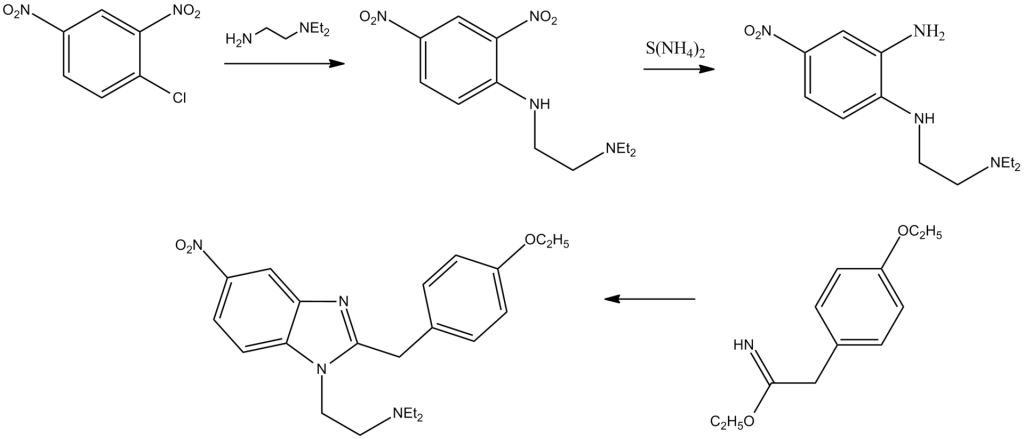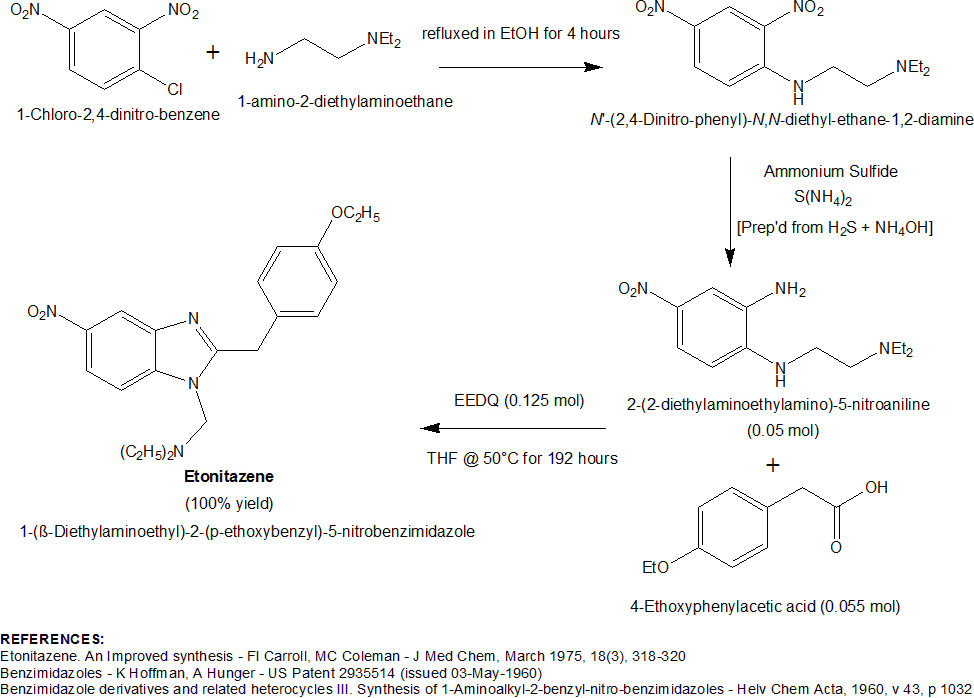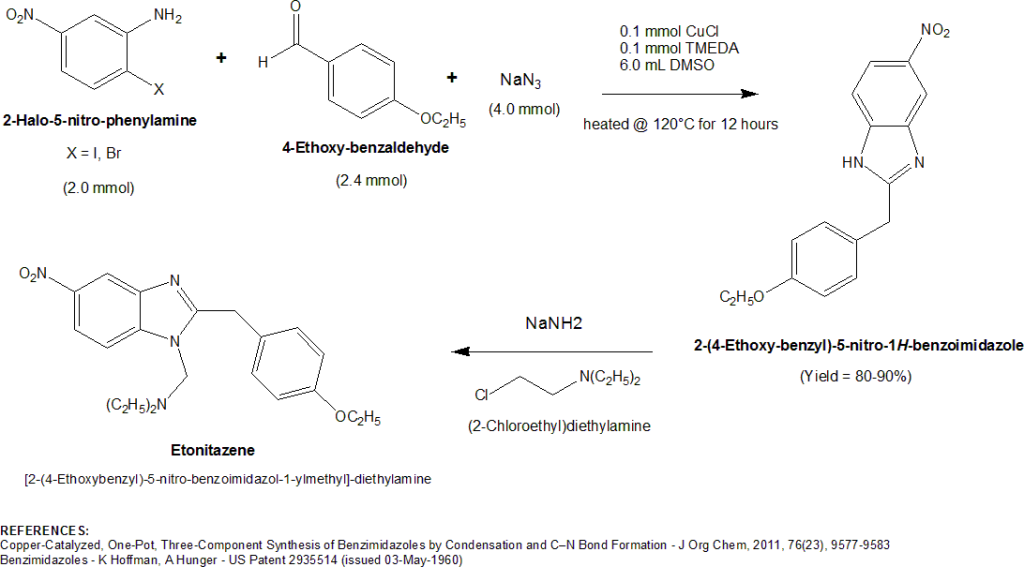Summary
Etonitazene, also referred to as EA-4941 or CS-4640, is a benzimidazole opioid. Its discovery dates back to 1957. Studies have indicated that it possesses an astonishing potency level, estimated to be roughly 1,000 to 1,500 times more potent than morphine when tested in animals.
Due to its marked potential for causing dependence and a propensity to induce severe respiratory depression, Etonitazene is not administered to humans. However, it finds utility in research involving addiction, especially in animal models that necessitate the consumption or ingestion of the substance. This is primarily because Etonitazene is less bitter compared to opiate salts like morphine sulfate, making it more suitable for such research applications.
| Identifiers | |
|---|---|
| IUPAC name | |
| CAS Number | 911-65-9 |
|---|---|
| PubChem CID | 13493 |
| IUPHAR/BPS | 1624 |
| DrugBank | DB01462 |
| ChemSpider | 12908 |
| UNII | 9U3GT3353T |
| ChEMBL | ChEMBL312040 |
| CompTox Dashboard (EPA) | DTXSID6048919 |
| ECHA InfoCard | 100.011.827 |
| Chemical and physical data | |
| Formula | C22H28N4O3 |
| Molar mass | 396.491 g·mol−1 |

Synthesis
Etonitazene and its related opioid agonists, known as benzimidazoles, were initially discovered during the late 1950s by a team of Swiss researchers employed at the pharmaceutical company CIBA, now known as Novartis. Among the first compounds explored by this Swiss team was 1-(β-diethylaminoethyl)-2-benzylbenzimidazole, which exhibited approximately 10% of the analgesic activity of morphine based on evaluations conducted with rodent bioassays. This initial discovery spurred the group to embark on an extensive and systematic investigation of 2-benzyl benzimidazoles, aiming to establish the structure-activity relationships within this novel class of analgesic substances. To facilitate the synthesis of these compounds, two general methods were developed.
The first method involved the condensation of o-phenylenediamine with phenyl acetonitrile, resulting in the formation of a 2-benzyl benzimidazole. Subsequently, this benzimidazole was subjected to alkylation using the desired 1-chloro-2-dialkylaminoethane, ultimately yielding the final product. This specific procedure proved highly effective for generating benzimidazoles that did not feature substituents on the benzene rings. A visual representation of this method is presented below.

The Swiss research team developed a highly versatile synthesis method, primarily commencing with the alkylation of 2,4-dinitrochlorobenzene with 1-amino-2-diethylaminoethane. This process yields N-(β-diethylaminoethyl)-2,4-dinitroaniline, also known as N’-(2,4-Dinitrophenyl)-N,N-diethyl-ethane-1,2-diamine. Subsequently, the 2-nitro group on the 2,4-dinitroaniline compound is selectively reduced to its corresponding primary amine, employing ammonium sulfide as the reducing agent. Ammonium sulfide can be generated in situ by introducing concentrated aqueous ammonium hydroxide and then saturating the solution with hydrogen sulfide gas.
The intermediate product, 2-(β-diethylaminoethylamino)-5-nitroaniline, is further reacted with the hydrochloride salt of the imino ethyl ether of 4-ethoxyphenylacetonitrile, also referred to as p-ethoxybenzyl cyanide. The imino ether, 2-(4-Ethoxyphenyl)-acetamide acid ethyl ester hydrochloride, is prepared by dissolving 4-substituted benzyl cyanide in a mixture of anhydrous ethanol and chloroform, followed by saturating the solution with dry hydrogen chloride gas. The interaction between the 2-(β-dialkylaminoalkylamine)-5-nitroaniline and the HCl salt of the imino ethyl ether leads to the formation of etonitazene. This synthesis procedure is notably valuable for producing 4-, 5-, 6-, and 7-nitrobenzimidazoles. By varying the choice of substituted phenylacetic acid imino ether, a range of compounds with diverse substituents on the benzene ring at the 2-position can be synthesized. A diagram illustrating this specific synthesis as it pertains to etonitazene preparation is presented below.

A remarkably innovative and high-yielding approach to synthesizing etonitazene was devised by FI Carroll and MC Coleman during the mid-1970s. The motivation behind this endeavor was the necessity for producing substantial quantities of etonitazene, for which the conventional synthesis method fell short. The primary issue with the traditional approach centered on the instability of the imino ether reactant, 2-(4-Ethoxyphenyl)-acetamide acid ethyl ester (prepared by reacting 4-ethoxyphenylacetonitrile with ethanolic HCl). The imino ether mandated the use of anhydrous reaction conditions and posed challenges in scaling up production.
In response to these challenges, the authors decided to explore the utilization of a coupling reagent known as EEDQ (N-Ethoxycarbonyl-2-ethoxy-1,2-dihydroquinoline) to facilitate the condensation process between 2-(2-diethylaminoethylamino)-5-nitroaniline and 4-ethoxyphenylacetic acid. Through experimentation, they uncovered that conducting this condensation in the presence of 2 or more molar equivalents of EEDQ (added incrementally in 3 stages) in THF at 50°C for 192 hours (8 days) yielded nearly quantitative results, achieving a remarkable 100% yield of etonitazene. This revised approach not only delivered a substantial improvement in yield compared to the conventional procedure but also simplified the subsequent work-up process, as the only by-products generated were quinoline, carbon dioxide, and ethanol. The process is outlined in the diagram below.

In 2011, a South Korean research team introduced an innovative, one-pot synthesis method [J. Org. Chem., 2011, 76(23), 9577-9583] for both substituted and unsubstituted 2-benzyl-benzimidazoles, which could be readily adapted for the production of etonitazene. This three-component synthesis aimed to create the immediate precursor of etonitazene, known as 2-(4-Ethoxybenzyl)-5-nitro-1H-benzoimidazole, through a single process.
The synthesis involved the following components: 2-Bromo- or 2-Iodo-5-nitro-phenylamine (1.0 molar equivalent), a 4-substituted benzaldehyde (1.2 equiv), and sodium azide (2 equiv). It’s worth noting that the 2-Halo-5-nitro-phenylamine required a bromo or iodo group for optimal reactivity, as 2-chloro-phenylamines exhibited no reactivity. Furthermore, the reaction was fine-tuned by incorporating 0.05 molar equivalents (5 mol%) of a catalyst, copper(I) chloride, and 5 mol% of the ligand TMEDA (tetramethylethylenediamine). These components were heated together at 120°C for 12 hours in DMSO, resulting in the direct etonitazene precursor, 2-(4-Ethoxybenzyl)-5-nitro-1H-benzoimidazole, with an approximate yield of 80-90%. Subsequently, the secondary amine nitrogen of 2-(4-Ethoxybenzyl)-5-nitro-1H-benzoimidazole was alkylated using (2-Chloroethyl)diethylamine to produce etonitazene. A diagram illustrating this synthesis process is presented below.

Analogs
Numerous analogs of etonitazene have been identified, with clonitazene being the most notable compound to emerge from the original 1950s research. However, it exhibits significantly lower potency than etonitazene (approximately three times weaker than morphine). In recent years, starting around late 2018, a variety of designer analogs have surfaced in illicit markets worldwide. The most prominent among these compounds include metonitazene, isotonitazene, and etazene, among others that continue to emerge.
Among these analogs, only etonitazene and clonitazene are explicitly listed in UN conventions, making them subject to international control measures. Consequently, they are regulated across the globe. The other analogs would only be prohibited in countries like the United States, Australia, and New Zealand that have legislation akin to the Federal Analog Act. In the United States, specifically, etonitazene is classified as a Schedule I narcotic controlled substance, designated with a DEA ACSCN of 9624 and a manufacturing quota of 25 grams as of 2022.
Illicit production
The illicit production and distribution of etonitazene have been relatively limited. It first emerged on the illegal drug market in Moscow in 1998, where it was predominantly consumed by smoking adulterated cigarettes. Interestingly, a chemist employed at Morton Thiokol synthesized the compound for personal use.
Etonitazene was manufactured in Russia back in 1996 and marketed under the name ‘Chinese Dwarf.’ Its consumption resulted in a number of unconfirmed fatalities due to the uncertainty surrounding its potency. Evidently, it exhibits a steep dose-response relationship and unpredictable pharmacokinetics, particularly when administered via injection, resembling the characteristics of certain other potent opioids like dextromoramide. This unpredictability may render etonitazene exceptionally hazardous compared to opioids of similar potency, such as fentanyl.
FAQ
- What is Etonitazene?
- Etonitazene is a powerful synthetic opioid analgesic that was first discovered in the late 1950s. It is known for its exceptionally high potency, estimated to be approximately 1,000 to 1,500 times that of morphine in animal studies.
- Has Etonitazene been used in medical practice?
- No, Etonitazene has never been approved for medical use in humans due to its potent opioid effects, high potential for dependence, and the risk of severe respiratory depression. It is classified as a research chemical.
- Why is Etonitazene not used in medical settings?
- Etonitazene is not used medically because of its extreme potency, which makes it challenging to administer safely. Its potential for addiction and life-threatening respiratory depression also makes it unsuitable for human use.
- Is Etonitazene legal?
- The legal status of Etonitazene varies by country and region. In many countries, it is considered illegal, and its production, sale, and possession are prohibited. In the United States, it is classified as a Schedule I controlled substance.
- Are there analogs or derivatives of Etonitazene?
- Yes, several analogs and derivatives of Etonitazene exist. Clonitazene is one of the better-known analogs, although it is much less potent than Etonitazene. In recent years, designer analogs like metonitazene, isotonitazene, and etazene have also appeared on illicit markets.
- What are the risks associated with Etonitazene use?
- Etonitazene use poses significant risks, including overdose, respiratory depression, dependence, and addiction. Due to its high potency, even small amounts can lead to life-threatening effects.
- How is Etonitazene typically consumed?
- Etonitazene has been reported to be consumed in various ways, including smoking in laced cigarettes and intravenous injection. The mode of consumption can significantly impact its effects and risks.
- Is Etonitazene associated with fatalities?
- Yes, Etonitazene has been linked to numerous fatalities, especially when consumed in an unregulated or illicit context. Its extreme potency and unpredictable pharmacokinetics can contribute to fatal outcomes.
- Is Etonitazene legally controlled worldwide?
- While Etonitazene and its analogs are controlled substances in many countries, the specific legal status varies. Some countries have stricter regulations, while others may not explicitly control it under international conventions.
- Is there any legitimate use for Etonitazene?
- Etonitazene is primarily used for research purposes, particularly in studies related to addiction and the opioid receptor system. It is not intended for human medical use.
References
- Anvisa (2023-03-31). “RDC Nº 784 – Listas de Substâncias Entorpecentes, Psicotrópicas, Precursoras e Outras sob Controle Especial” [Collegiate Board Resolution No. 784 – Lists of Narcotic, Psychotropic, Precursor, and Other Substances under Special Control] (in Brazilian Portuguese). Diário Oficial da União (published 2023-04-04). Archived from the original on 2023-08-03. Retrieved 2023-08-16.
- King JW, Cleveland JP, Lennox WJ (November 1991). Williams JD, Reeves PJ (eds.). Synthesis and Bioactivity of 2-(Alpha-Hydroxy-Para-Alkoxybenzyl) and 2-Alkoxy Arylamino Analogs of Etonitazene (CS – 4640). Proceedings of the U.S. Army Chemical Research, Development and Engineering Center Scientific Conference on Chemical Defense Research. Aberdeen Proving Ground, Maryland: Edgewood Research, Development and Engineering Center, Aberdeen Proving Ground, MD.
- US patent 2935514, Hoffmann K, Hunger A, Kebrle J, Rossi A, “Benzimidazoles”, published 1957-09-19, issued 1960-05-03, assigned to Ciba Pharmaceutical Products Inc., Summit, NJ.
- Wikler A, Martin WR, Pescor FT, Eades CG (October 1963). “Factors Regulating Oral Consumption of an Opioid (Etonitazene) by Morphine-Addicted Rats”. Psychopharmacologia. 5 (1): 55–76. doi:10.1007/BF00405575. PMID 14082382. S2CID 38073529.
- Hunger A, Kebrle J, Rossi A, Hoffmann K (October 1957). “[Synthesis of analgesically active benzimidazole derivatives with basic substitutions]” [Synthesis of analgesically active benzimidazole derivatives with basic substitutions]. Experientia. 13 (10): 400–401. doi:10.1007/BF02161116. PMID 13473817. S2CID 32179439.
- Rossi A, Hunger A, Kebrle J, Hoffmann K (1960). “Benzimidazol-Derivate und verwandte Heterocyclen. IV. Die Kondensation von o-Phenylendiamin mit α-Aryl- und γ-Aryl-acetessigester” [Benzimidazole derivatives and related heterocycles IV. The condensation of o-phenylenediamine with α-aryl and γ-aryl-acetoacetate]. Helvetica Chimica Acta (in German). 43 (4): 1046–1056. doi:10.1002/hlca.19600430413.
- Rossi A, Hunger A, Kebrle J, Hoffmann K (1960). “Benzimidazol-Derivate und verwandte Heterocyclen V. Die Kondensation von o-Phenylendiamin mit aliphatischen und alicyclischen β-Ketoestern” [Benzimidazole derivatives and related heterocycles V. The condensation of o-phenylenediamine with aliphatic and alicyclic β-keto esters]. Helvetica Chimica Acta (in German). 43 (5): 1298–1313. doi:10.1002/hlca.19600430515.
- Hunger A, Kebrle J, Rossi A, Hoffmann K (1960). “Benzimidazol-Derivate und verwandte Heterocyclen VI. Synthese von Phenyl-[1-aminoalkyl-benzimidazolyl-(2)]-essigsäure-estern und -amiden” [Benzimidazole derivatives and related Heterocycles VI. Synthesis of phenyl-[1-aminoalkyl-benzimidazolyl-(2)]-acetic acid esters and amides]. Helvetica Chimica Acta (in German). 43 (6): 1727–1733. doi:10.1002/hlca.19600430634.
- Hunger A, Kebrle J, Rossi A, Hoffmann K (1961). “Benzimidazol-Derivate und verwandte Heterocyclen VII. Synthese neuer 2-Amino-benzimidazole” [Benzimidazole Derivatives and related Heterocycles VII. Synthesis of new 2-amino-benzimidazole]. Helvetica Chimica Acta (in German). 44 (5): 1273–1282. doi:10.1002/hlca.19610440513.
- Gross F, Turrian H (October 1957). “[Benzimidazole derivatives with strong analgesic effects]” [Benzimidazole derivatives with strong analgesic effects]. Experientia. 13 (10): 401–403. doi:10.1007/BF02161117. PMID 13473818. S2CID 6824038.
- Hunger A, Kebrle J, Rossi A, Hoffmann K (1960). “Benzimidazol-Derivate und verwandte Heterocyclen. II. Synthese von 1-Aminoalkyl-2-benzyl-benzimidazolen” [Benzimidazole derivatives and related heterocycles II. Synthesis of 1-aminoalkyl-2-benzyl-benzimidazoles]. Helvetica Chimica Acta (in German). 43 (3): 800–809. doi:10.1002/hlca.19600430323.
- Carroll FI, Coleman MC (March 1975). “Etonitazene. An improved synthesis”. Journal of Medicinal Chemistry. 18 (3): 318–320. doi:10.1021/jm00237a024. PMID 237125.
- Kim Y, Kumar MR, Park N, Heo Y, Lee S (December 2011). “Copper-catalyzed, one-pot, three-component synthesis of benzimidazoles by condensation and C-N bond formation”. The Journal of Organic Chemistry. 76 (23): 9577–9583. doi:10.1021/jo2019416. PMID 22034860.
- Blanckaert P, Cannaert A, Van Uytfanghe K, Hulpia F, Deconinck E, Van Calenbergh S, Stove C (April 2020). “Report on a novel emerging class of highly potent benzimidazole NPS opioids: Chemical and in vitro functional characterization of isotonitazene”. Drug Testing and Analysis. 12 (4): 422–430. doi:10.1002/dta.2738. PMID 31743619. S2CID 208187034.
- Vandeputte M, Van Uytfanghe K, Layle N, Germaine DS, Iula D, Stove C (12 November 2020). “Synthesis, chemical characterization, and µ-opioid receptor activity assessment of the emerging group of nitazene new synthetic opioids”. Authorea. doi:10.22541/au.160520665.59016513/v1. S2CID 234646245.
- Sorokin VI, Ponkratov KV, Drozdov MA (1999). “Etonitazene Encountered in Moscow”. Microgram. 32 (9): 239–244.
- Reavy P (3 June 2003). “Chemist charged in drug case”. Deseret News. Salt Lake City. Archived from the original on March 7, 2014.
- “Этонитазен (etonitazene) – описание препарата” [Etonitazene (etonitazene) – a description of the drug] (in Russian). Social Services LLC. Archived from the original on 23 March 2019.
- Kishioka S, Ko MC, Woods JH (May 2000). “Diltiazem enhances the analgesic but not the respiratory depressant effects of morphine in rhesus monkeys”. European Journal of Pharmacology. 397 (1): 85–92. doi:10.1016/s0014-2999(00)00248-x. PMID 10844102.
